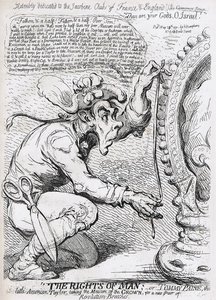"The Rights of Man"; or - Tommy Paine, the Little American Taylor, Taking the Measure of the Crown, for a New Pair of Revolution Breeches
Only £225.00
Size 26cm x 36cm
Originally published by Hannah Humphrey etched by James Gillray from 'The Genuine Works of James Gillray, engraved by himself. Thomas McLean edition on heavy rag-paper from the original copper plates printed 1830.
One of the functions of caricature, especially satiric caricature, is to diminish its subject, to suggest that the person being caricatured is either literally or figuratively not as large or important as one would suppose. This is certainly the objective of Gillray in this print.
Thomas Paine, the author of Common Sense (1776) had been enormously important in helping persuade the American colonists to declare their independence from Britain. Within the first three months after its publication, his pamphlet is supposed to have sold 100,000 copies in the colonies. But the thrust of the argument, however, was not simply for the necessity of independence from Britain but against the power of the crown. "The nearer any government approaches to a Republic," Paine argued, "the less business there is for a King." And further, "Of more worth is one honest man to society, and in the sight of God, than all the crowned ruffians that ever lived."
In March of 1791, Paine was at it again, responding to Edmund Burke'sReflections on the Revolution in France (1790) with a longer, more closely argued tract, The Rights of Man, and extending his argument for locating the source of political authority in the will of the people rather than the hereditary succession of king and crown. It was an argument that had enormous appeal to dissenters, parliamentary reformers, whigs, and to the left-leaning Jacobin clubs of both France and England. It is this context that we must see Gillray's The Rights of Man, or Tommy Paine, the Little American Taylor taking the Measure of the Crown for a new Pair of Revolution Breeches published in May of 1791.
Paine is diminished in multiple ways. First of all by being described in the subtitle as "the little American Taylor" (he was actually mid-sized and English) and then visually by being miniaturized next to the large crown he attempts to measure.
He is then diminished socially by being portrayed as a lowly tailor and revolutionary. Having begun his working life as a stay maker in his father's business, Paine is shown clad in tattered and threadbare clothes, with a large shears at his side, and using a tailor's tape in a pathetic and failed attempt to "take the measure" of the English crown. He wears a cocked hat and plume adorned with a tri-colored revolutionary cockade.
It is probable that Gillray had never met Paine or seen a print of his face, because it is not until Fashion Before Ease. . . two years later that he produces an actual caricature of Paine's appearance. Instead he uses here the typical long-jawed and dim-witted generic caricature of a revolutionary seen in other Gillray prints like The National Assembly Revivified (1791). But it certainly serves Gillray's purposes to make Paine appear as common and beggarly as he can.
There is an unusual number of verbal allusions in the print. First, the ironic dedication to the "the Jacobine clubs of France & England by Common Sense," followed by the pointed allusion to the Biblical verse in Exodus 32:8, "These be thy gods, O Israel." In that verse, God laments that, in the absence of Moses, the Israelites have turned aside from his commandments and begun worshipping a golden calf. The suggestion, then, is that the left wing followers of Paine have mistaken their gods and Gillray is showing them, with true common sense, a more accurate image of their idol.
Finally, there is the allusion to the madman "poor Tom," in Act Three, Scene Four of King Lear who is doing his own measurement "Fathom and a half" of the effects of the storm upon his hovel in the middle of the heath. Gillray does an excellent job of imitating that mad stream of consciousness as his poor Tom Paine laments that with all his experience as a tailor, he cannot truly take the measure of the crown and its significance for the British people nor stitch up the mouth of Burke and his Reflections. The conclusion is that Paine is not only small and poor, but mad.
But in choosing poor Tom from Lear (the noble Edgar in disguise) to represent Paine, Gillray may perhaps unwittingly betray a certain sympathy for his cause, and a certain befuddlement (shared by some Englishmen today) at the power of the crown as a symbol of British government, "for what is a crown but a bauble which we may see in the Tower for Six-pence a piece"?
 View Account
View Account
